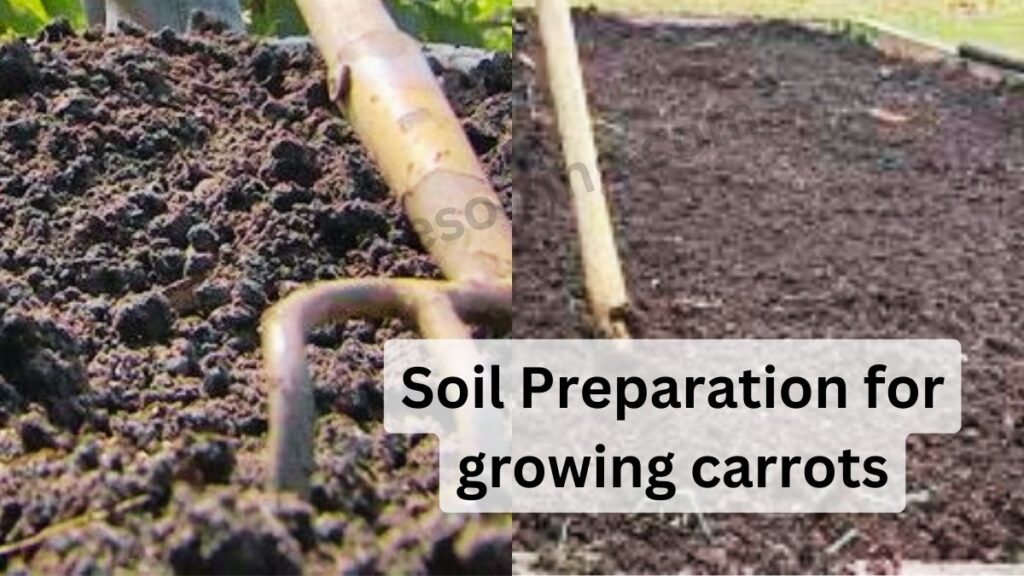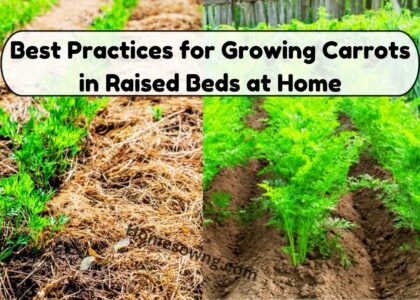Carrots, the vibrant orange root vegetables, are a staple in many cuisines worldwide, valued for their nutritional richness and culinary versatility. Cultivating carrots in your home garden offers the satisfaction of harvesting fresh, wholesome produce while enjoying nurturing life from seed.
1. Selection of Site for Carrots
The journey towards abundant carrot harvests begins with selecting an ideal planting site and preparing the soil to provide the necessary nutrients and support for healthy growth.
Selection of Site for Growing Carrots
Choosing the right site is important for a successful carrot harvest! Here’s what you need to consider
1. Sunlight
Carrots thrive in sunny locations, requiring at least 6-8 hours of direct sunlight daily. Choose a site that receives ample sunlight throughout the growing season.
2. Soil Drainage
Well-drained soil is crucial for preventing root rot and ensuring optimal growth. Avoid planting carrots in areas prone to waterlogging or with heavy clay soils that compact easily.
3. Soil pH
Carrots prefer slightly acidic to neutral soil with a pH range of 6.0 to 7.0. Test your soil’s pH level and adjust it using lime or sulfur if necessary.
2. Soil Preparation for growing carrots
Proper soil preparation is key to growing long, straight, and delicious carrots! Here’s what you need to do
1. Deep Tillage
Loosen the soil to a depth of 8-12 inches to promote root penetration and aeration. This is especially important for compacted or heavy clay soils.
2. Organic Matter
Enrichment: Incorporate generous amounts of organic matter such as well-rotted manure, compost, or aged peat moss. This improves soil structure, drainage, and nutrient content.

3. Carrots Growing Stages
With the site selected and the soil prepared, the next step is sowing the carrot seeds, marking the beginning of their journey from tiny seeds to flavorful roots.
Time of Sowing
In cooler regions, ow carrot seeds in late spring or early fall when soil temperatures reach at least 45-50°F (7-10°C).
In warmer areas, sow carrot seeds earlier in the spring or later in the fall, ensuring soil temperatures are warm enough for germination.
Method of Sowing
Choosing the right method for sowing your carrots can significantly impact your harvest’s success. Here are several options to consider, each with its advantages and challenges
1. Furrow Creation
Create shallow furrows or trenches about 1/4 inch (0.5 cm) deep and 12-18 inches (30-45 cm) apart.
2. Seed Distribution
Sow the seeds thinly along the furrows, spacing them about 1-2 inches (2.5-5 cm) apart.
3. Seed Covering
Cover the seeds with fine soil and gently firm the surface.
4. Watering
Water the newly sown seeds thoroughly to ensure proper germination.
5. Thinning and Weeding
Ensuring Healthy Growth and Competition Control. As carrot seedlings emerge, thinning and weeding become essential practices to promote healthy growth and prevent overcrowding.
4. Nurturing Carrot Growth and Development
Providing consistent moisture and nutrients is crucial for nurturing carrot growth and ensuring a bountiful harvest.
Watering
Watering carrots effectively can be tricky, but by understanding their needs and applying some key principles, you can ensure delicious, juicy carrots! Here’s a guide to watering your carrot patch
1. Frequency
Carrots require consistent moisture for optimal growth. Water regularly, especially during dry periods.
2. Depth
Water deeply to encourage deep root growth.
3. Method
Avoid overhead watering, which can promote fungal diseases. Instead, water is directly at the base of the plants.
5. Application of Fertilizer
Fertilizing carrots in your home garden requires a balanced approach to provide the necessary nutrients for optimal growth without overdoing it.
6. Control of Pests and Diseases
Monitor carrot plants for common pests like carrot flies and carrot weevils. Use organic pest control methods like insecticidal soap or neem oil if necessary.
7. Harvesting of Carrot
Carrots are ready to harvest when they reach a suitable size for your desired use. For baby carrots, harvest them when they are about ½ inch in diameter. For mature carrots, wait until they reach a diameter of 1-2 inches. Harvesting time typically ranges from 60 to 120 days after planting, depending on the variety and growing conditions.










